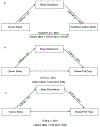Cancer survivors in the workplace: sleep disturbance mediates the impact of cancer on healthcare expenditures and work absenteeism
- PMID: 29869719
- PMCID: PMC6204101
- DOI: 10.1007/s00520-018-4272-4
Cancer survivors in the workplace: sleep disturbance mediates the impact of cancer on healthcare expenditures and work absenteeism
Abstract
Purpose: History of cancer is significantly associated with increases in healthcare costs, worse work performance, and higher absenteeism in the workplace. This is particularly important as most cancer survivors return to employment. Sleep disturbance is a largely overlooked potential contributor to these changes.
Methods: Data from 9488 state employees participating in the Kansas State employee wellness program were used to assess cancer history, sleep disturbance, healthcare expenditures, work performance ratings, and absenteeism. Participants were categorized as having had no history of breast or prostate cancer, a past history only with no current cancer treatment, or current treatment for breast or prostate cancer. Indirect mediation analyses determined whether sleep disturbance mediated the influence of cancer status on outcomes.
Results: Employees receiving treatment for breast or prostate cancer had significantly greater healthcare expenditures and absenteeism than those with a past history or no history of cancer (ps < .0001). Sleep disturbance significantly mediated the impact of cancer on healthcare expenditures and absenteeism (ps < .05), accounting for 2 and 8% of the impact of cancer on healthcare expenditure and missed full days of work, respectively.
Conclusions: The worse outcomes observed among employees receiving treatment for breast and prostate cancer, the most common forms of cancer among women and men, were partially explained by the impacts of cancer and treatment for cancer on sleep disturbance. These findings suggest that preventing or addressing sleep disturbance may result in economic benefits in addition to improvements in health and quality of life.
Keywords: Absenteeism; Cancer; Healthcare costs; Quality of life; Sleep.
Conflict of interest statement
The authors have no conflicts of interest to declare.
Figures

References
-
- American Cancer Society (2016) Cancer Treatment and Survivorship Facts & Figures 2016–2017. American Cancer Society, Atlanta
-
- Siegel RL, Miller KD, Jemal A (2016) Cancer statistics, 2016. CA: A Cancer Journal for Clinicians 66 (1):7–30 - PubMed
-
- Institute of Medicine (2006) Employment, Insurance, and Economic Issues In: Hewitt ME, Greenfield S, Stovall E (eds) From Cancer Patient to Cancer Survivor: Lost in Transition. National Academies Press, Washington, DC, pp 363–342
MeSH terms
Grants and funding
LinkOut - more resources
Full Text Sources
Other Literature Sources
Medical
Miscellaneous

